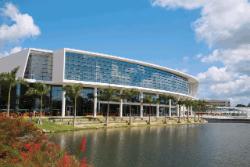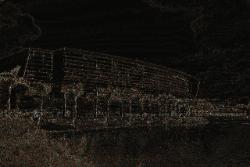In the six years since the department launched its Ph.D. program, its advanced students have engaged in research with applications for healthcare, robotics and beyond – with remarkable potential to change our world.
 |
 |
| The image of the Student Activities Center (left) is made up of thousands of pixels, each of which is coded with a significant amount of information (right). Computer science graduate student Basar Koc created these images to demonstrate his work with data compression. |
|
Justin Stoecker, the program’s first graduate (Ph.D., 2014), is now working as a software engineer at Microsoft Corporation. Stoecker also earned his B.S. and M.S. degrees in computer science at UM. During his time on campus, he was involved with the development of interactive visualization systems.
“Interactivity in visualization can enable novel experiences, but it also tends to present interesting challenges from a computer science perspective,” Stoecker said.
For his master’s thesis, he worked with geophysicists at UM’s Rosenstiel School of Marine and Atmospheric Science to incorporate various forms of seismic data into a visualization model that allowed scientists to “fly through a three-dimensional space to see the relationships between different data sets and the changes over time,” he said. This system was utilized for reconstruction planning following the 2010 Haiti earthquake, and has helped scientists to assess the risk for future seismic activity in the region.
Stoecker’s Ph.D. project was the development of a system that allows physicians in an operating room to view patient imagery hands-free.
“It’s important to maintain a sterile environment during a procedure, and touching surfaces unnecessarily is always a risk,” Stoecker said. His project combines 3D views of a patient’s anatomy (generated through CT scans, MRIs, etc.) with a gesture-based interface that allows users to manipulate the visualization.
This work, a collaboration with physicians at the Oregon Health & Science University, has the potential to revolutionize healthcare training, and to help all doctors more effectively plan and execute surgical procedures.
Professor Victor Milenkovic supervised Stoecker’s research. He said, “Justin taught himself a large amount of sophisticated graphics techniques and technologies. He is an expert on coming up with ways to use these technologies to facilitate other tasks.”
Stoecker says he had one motivation for pursuing a Ph.D. in computer science: “Graduate study in computer science really ties together a lot of the topics that are briefly touched upon during undergraduate years. There is also a clear emphasis on investigating issues in computer science that are truly fundamental; this makes it easier to distinguish noteworthy ideas from fleeting trends in computing.”
Basar Koc, a current graduate student in computer science, is pursuing his Ph.D. to become “an expert in one field.”
Koc’s field is data and image compression. Images are made up of thousands of pixels, each of which is coded with a significant amount of information.
“A picture is a huge amount of numerical data,” said Professor Huseyin Kocak, who advises Koc. He explained that images can be compressed for easier storage and sharing. However, when expanded, they must revert to exactly the same as their original state.
This so-called “lossless image compression” is necessary for images used in a healthcare setting, such as mammogram data and other medical results.
Koc is working to create the best algorithm so images can be “transported, read, and stored without any loss of data,” Kocak said.
He added: “Basar is not afraid of venturing out of his comfort zone in his research. He is one of the most accomplished graduate students I have encountered at the University of Miami. I learned more from him than what he learned from me.”
Senior Ph.D. student Saminda Abeyruwan is a skilled teacher and researcher.
His advisor, Associate Professor Ubbo Visser, said, “Saminda has an open mind, a characteristic that every researcher needs to have.”
Abeyruwan works with Visser on UM’s RoboCanes project, a team of five autonomous robotic soccer players that can learn from experience, make split-second decisions and communicate with one another.
The RoboCanes have found success in national and international competitions, including taking second place in the 2014 RoboCup in João Pessoa, Brazil.
Abeyruwan and Visser are also collaborating on the RegenBase project, working with the Miami Project to Cure Paralysis on a searchable, comprehensive information framework and knowledge base that will advance the field of axon regeneration. This will help medical researchers develop therapeutically relevant genes and drugs for future clinical trials.
“Interdisciplinary work is essential to solve complex problems these days,” Visser said. “Four years of studying computer science is a very good foundation. However, software developers find themselves in a situation where more and more complex problems need to be tackled. This requires specific skills that are covered in advanced (graduate) courses at universities.”
March 25, 2015

